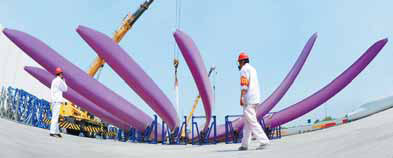Central, western areas to play larger trade role
|
Wind power equipment ready to be exported at a company in Lianyungang, Jiangsu province. Ji Zhiqiang / for China Daily |
Companies in energy, grain sectors have chance to lift competitiveness
More companies in the central and western regions of the country are joining the ranks of the nation's top 500 foreign traders, according to a report by the Statistical Society for Foreign Economic Relations and Trade of China.
China Petrochemical Corp retained its top spot on the list with a trade volume of $111.9 billion last year, while Shanghai Roche Pharmaceuticals Co Ltd was at the bottom with a trade volume of $707.9 million.
The trade volume of the top 500 foreign traders has grown annually since 1996 and stood at $1.357 trillion last year, up 20.48 percent year-on-year, accounting for 37.26 percent of China's foreign trade last year, according to the report.
"The top 500 foreign traders are the 'cornerstone' of China's foreign trade and have a key role in helping meet the government's trade growth goal of 10 percent this year," said Liu Kuangyuan, the association's president.
"Structural changes in these 500 companies reflect the development of the country's foreign trade."
China's foreign trade grew 7.7 percent in the first five months of this year, according to the General Administration of Customs.
Commerce Minister Chen Deming said on Monday that the best possible outlook for China's foreign trade growth this year could be around 10 percent, but he warned that challenging conditions would remain in the rest of the year.
The top 500 companies' share of exports dropped from 37.88 percent in 2010 to 37.26 percent last year.
Share of imports by these companies edged up to 45.11 percent last year from 44.22 percent in 2010, which is "closely related to China's strong demand for bulk commodities including energy, resources and agricultural products", said the report.
"China's imports in the next half of this year will see quite fast growth because China maintains a vigorous demand for raw materials and customs duties for consumer commodities were reduced recently. The whole year will see almost balanced trade with a small trade surplus," said Xiang Songzuo, chief economist of Agricultural Bank of China.
"China's trade this year will grow by 10.7 percent year-on-year while exports will grow 9.4 percent and imports will increase by 12.1 percent. Given a stable international market, China will see faster trade growth in 2013, but it will remain slower than 2010," Liu said.
Newcomers
Major companies from the petrochemical, energy, oil and grain sectors figure prominently on the list.
These companies have great potential to increase their competitiveness, said the report.
"Companies from the petrochemical, electronics, oil and grain industries can still hold leading positions on the list in the short term, but more and more companies from others industries, especially high-tech, are now joining the list," Liu said.
In 2009, eight high-tech companies were among the top 10 exporters of the top 500 foreign traders, while all 10 places were occupied by high-tech exporters last year.
However, the manufactured exports of the top 500 foreign traders, such as apparel, footwear and primary chemicals, are still at a low level, said the report.
"Rising labor and energy costs and currency appreciation are eroding the comparative advantage of Chinese exporters. Though we are the biggest electronics exporter, we do not have the core technology," said Li Yizhong, head of the China Federation of Industrial Economics.
"Exporters should now extend their industrial chains for higher added value and develop a new competitive edge supported by quality, brand and services while the sluggish world economy challenges China's export-oriented manufacturing industries," he said.
"Some well-developed companies can also go abroad for investment and tap the international market by setting up an overseas sales network and introducing e-commerce," Li added.
In addition, the report revealed that State-owned enterprises are gradually being replaced on the list by private companies.
Although companies from the eastern region dominate the list, their trade volume has fallen in recent years, said the report.
It fell from 98 percent of the total trade volume of the 500 top foreign traders in 2007 to 92.85 percent last year, according to the report.
A total of 455 companies on the list came from the eastern region last year, 10 less than in the previous year. The central region accounted for 21 in 2009 and 24 last year, while the number in the western region increased from 12 in 2010 to 21 last year, said the report.
lijiabao@chinadaily.com.cn



















